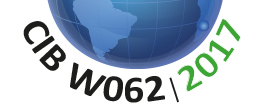CIB
CIB
CIB is the acronym of the abbreviated French (former) name: "Conseil International du Bâtiment" (in English this is: International Council for Building). In the course of 1998, the abbreviation has been kept but the full name changed into: INTERNATIONAL COUNCIL FOR RESEARCH AND INNOVATION IN BUILDING AND CONSTRUCTION.
CIB was established in 1953 as an Association whose objectives were to stimulate and facilitate international cooperation and information exchange between governmental research institutes in the building and construction sector, with an emphasis on those institutes engaged in technical fields of research.
CIB has since developed into a worldwide network of over 5000 experts from about 500 member organizations active in the research community, in industry or in education, who cooperate and exchange information in over 50 CIB Commissions covering all fields in building and construction related research and innovation.
CIB W062
CIB W062 on Water Supply and Drainage for Buildings was established in 1971. The Objectives of the Commission are:
- to report on research results, industrial developments and standardisation progress;
- to stimulate concerted research actions between different research teams;
- to coordinate the drafting of "states-of-the-art" for selected topics;
- to draw up inventories of research and bibliographic lists.
The Commission's Scope includes:
Water supply systems and drinking water treatment (softening, heating etc.) inside buildings;
Water (waste and rainwater) drainage systems in buildings and individual waste water treatment
Symposium objectives
The aim of the symposium is to provide a forum where participants will exchange information on:
- results of recent researches;
- industrial researches and developments;
- performances of building systems;
- models and procedures for design;
- codes of practice and standards.
Topics
1. Water supply including hygiene security
2. Water saving and water re-use
3. Drainage including health and hygiene aspects
4. Materials for water supply and drainage
5. Codes and standards
6. Computer modelling
Abstract Submission / Call for Papers
Authors are invited to submit an abstract (not exceeding 300 words) describing original research results, applications, or case studies for consideration and possible acceptance by the scientific committee. Go to Materials to see the instructions
